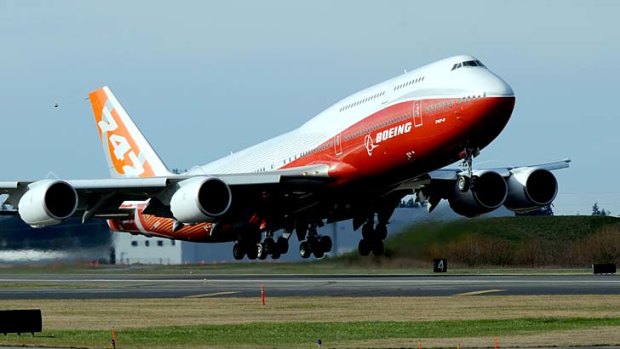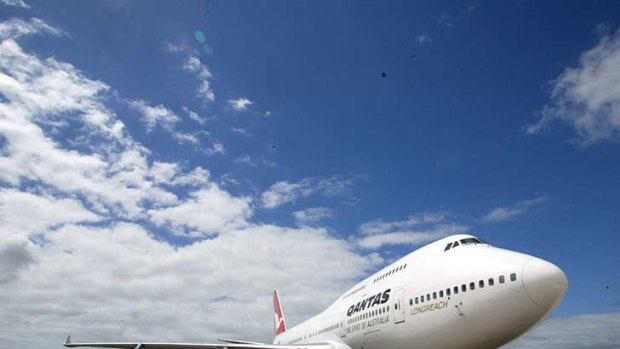Prices for Boeing 747-400s, the most popular wide-body plane, are tumbling as carriers rush to replace what were once their flagship aircraft with newer and more fuel-efficient models.
Ten-year-old passenger 747-400s are worth a record low $US36 million, about 10 per cent less than similar aged planes last year, according to Ascend Worldwide, amid high fuel costs and a cargo slump that has damped interest in converting aircraft into freighters. Forty-eight of the 404 humpbacked passenger 747-400s worldwide have also been placed in storage, according to the London-based aviation consultancy, as the once “Queen of the Skies” is shunned for 777s and Airbus A380s.
“There's not a lot of demand for the 747,” said Paul Sheridan, Ascend's Hong Kong-based head of risk analysis. “They're mostly being broken up for parts.”

The 747-8 Intercontinental, Boeing's latest version of the iconic passenger jet. The jumbo jet has fallen out of favour in recent years, as airlines retire their older 747-400s in favour of smaller aircraft or larger Airbus A380s.Credit: AFP
The decline in prices contributed to Singapore Airlines having a surprise loss in the quarter ended March after the sale of the carrier's last 747-400 raised less than it expected. Japan Airlines has also stopped using the planes, and operators including Cathay Pacific Airways, Korean Air Lines and Malaysia Airlines are following suit to help counter fuel prices that have jumped about 30 percent in two years.
“When oil prices are high, you want your new plane,” Cathay Pacific Chief Executive Officer John Slosar said this week in Beijing. “The last thing you want to do is hold onto your older planes.”
The Hong Kong-based airline said last month that it's speeding up the retirement of its 21 passenger 747-400s. The carrier plans to shed nine through early 2014 as it adds more 777-300ERs for long-haul flights. Cathay is also retiring three -400 freighters this year because of the arrival of new 747-8 cargo planes.

Qantas still maintains a small fleet of Boeing 747-400s.Credit: Andrew De La Rue
1960s Development
The first four-engine 747-400 was delivered to Northwest Airlines in 1989. The standard version can fly as far as 13,450 kilometres, carrying 416 passengers in three classes, according to Boeing's website. The Chicago-based planemaker delivered the last of 694 -400s in 2009. The original 747 was developed in the 1960s.
The passenger version of the newest 747, the 747-8, entered service this year. It can fly 467 passengers in three classes as far as 12,870 kilometres. The twin-engine 777-330ER, first delivered in 2004, can carry 365 people as far as 12,760 kilometres.
“We're seeing a lot of airlines understanding that they need more fuel-efficient planes and that bodes very well for us,” Jim Albaugh, the head of Boeing's commercial-plane business, said in a Bloomberg TV interview.
Newer aircraft use less fuel because of the development of more efficient engines and of lightweight materials. The 787 has a fuselage built from reinforced plastics, compared with the 747's heavier aluminum shell.
Thai Airways
Thai Airways is in the process of selling four 747-400s and it will begin phasing out the model next year, outgoing-Chief Executive Officer Piyasvasti Amranand said May 31 in Bangkok. The carrier will begin receiving six on-order A380s this year.
Flying 747-400s now “doesn't make sense,” Amranand said. “It's obvious that with this sort of fuel price that it will cost you.”
Malaysia Airlines, which received its first A380 last month, will consume 1181 barrels of fuel flying the 494-seat aircraft to London from Kuala Lumpur, according to Maybank Kim Eng Securities analyst Wong Chew Hann. The carrier's 359-seat 747-400s use about 999 barrels of fuel on the same route, he said. Fuel accounts for about a third of airlines' costs, according to the International Air Transport Association.
A380 Prestige
The A380, which surpassed the 747-400 as the world's largest commercial plane on entering service in 2007, has become the flagship for carriers including Singapore Air and Qantas Airways (though Qantas still maintains a small fleet of 747-400s with refurbished A380-style interiors to operate some long-haul services).
Airlines still reliant on 747-400s are at a disadvantage in terms of costs and prestige, said Maybank's Wong.
“It takes an A380 to beat an A380,” he wrote in a June 8 note.
European carriers, operating in slower growth markets than Asian airlines, are replacing 747-400s less quickly. British Airways, the biggest operator, will only retire the last of its fleet in about 10 years. The carrier has 55 747-400s, according to Ascend.
“It's a great aircraft, customers love it,” said Willie Walsh, chief executive officer of BA's parent International Consolidated Airlines Group. “We could replace some of them with 777-300ERs, which we are doing, but we are not looking to replace all of them.”
BA has also ordered 12 A380s, which will start arriving in about a year. Lufthansa has already begun flying A380s and it has ordered 747-8s. It will still continue using 747-400s, partly because it owns rather than leases them, said Chief Executive Officer Christoph Franz.
“We still think it's an attractive aircraft and we will use it for quite a number of years,” Franz said. “They are very competitive aircraft in the market for us.”
Newer and smaller long-haul planes are also allowing carriers to open new routes that wouldn't be profitable with the 747-400. All Nippon Airways, which will retire its last seven 747s by March 2016, is starting flights from Tokyo to San Jose and Seattle using new 787s. Japan Air is using Dreamliners to open routes to Boston and San Diego.
The move away from larger planes has curtailed sales of the A380 and the 747-8, according to Richard Aboulafia, vice president of the Teal Group, a Fairfax, Virginia forecaster. Airbus has sold 253 A380s. Boeing has orders for 106 747-8s, of which only 27 are for commercial passenger operations.
“The market for large aircraft in general is disappearing fast,” Aboulafia said. “Most of the 747-8 planes are cargo. There's just a limited market.”
Bloomberg
Follow the Traveller section on Twitter @FairfaxTravel
Sign up for the Traveller newsletter
The latest travel news, tips and inspiration delivered to your inbox. Sign up now.